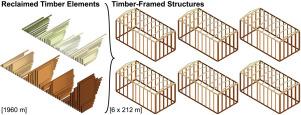Design and optimisation of timber-framed structures using a stock of reclaimed elements
IF 11.5
1区 工程技术
Q1 CONSTRUCTION & BUILDING TECHNOLOGY
引用次数: 0
Abstract
The reuse of reclaimed timber in structural applications is limited by irregular geometries and mixed material properties, posing complex optimisation challenges. This paper presents a computational framework for designing timber-framed modular buildings from mixed reclaimed material stock. It combines a set-based stock allocation method with an integer linear programming optimisation, where cutting and jointing patterns are decision variables. Two case studies demonstrate the framework, including the construction of multiple modular houses using nearly two kilometres of recycled timber. A globally optimal solution for six houses was found in under 1.5 s, using 760 parts with 77.6% stock utilisation and 83.7% cutting efficiency. Compared to existing stock-constrained structural design tools, the framework expands capability by handling mixed grades, stock allocation across structural subsystems, and enabling cutting and jointing into shorter, longer, or laminated members. It further allows near-real-time optimisation of materially efficient part arrangements within framed structural systems.

利用回收材料设计和优化木结构
再生木材在结构应用中的再利用受到不规则几何形状和混合材料特性的限制,提出了复杂的优化挑战。本文提出了一种利用混合再生材料设计木结构模块化建筑的计算框架。它将基于集合的库存分配方法与整数线性规划优化相结合,其中切割和连接模式是决策变量。两个案例研究展示了该框架,包括使用近两公里的回收木材建造多个模块化房屋。在1.5秒内找到了六个房屋的全球最佳解决方案,使用760个零件,77.6%的库存利用率和83.7%的切割效率。与现有的库存约束结构设计工具相比,该框架通过处理混合等级、跨结构子系统的库存分配以及切割和连接成短、长或层压构件来扩展能力。它还允许在框架结构系统内对材料有效的部件安排进行近乎实时的优化。
本文章由计算机程序翻译,如有差异,请以英文原文为准。
求助全文
约1分钟内获得全文
求助全文
来源期刊

Automation in Construction
工程技术-工程:土木
CiteScore
19.20
自引率
16.50%
发文量
563
审稿时长
8.5 months
期刊介绍:
Automation in Construction is an international journal that focuses on publishing original research papers related to the use of Information Technologies in various aspects of the construction industry. The journal covers topics such as design, engineering, construction technologies, and the maintenance and management of constructed facilities.
The scope of Automation in Construction is extensive and covers all stages of the construction life cycle. This includes initial planning and design, construction of the facility, operation and maintenance, as well as the eventual dismantling and recycling of buildings and engineering structures.
 求助内容:
求助内容: 应助结果提醒方式:
应助结果提醒方式:


